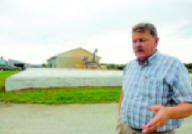|
Cow Power Turns Manure Into ElectricityLancasterFarming.com Leon Thompson 10/19/2013
SHELDON, Vt. — This idea was the seed, according to Bill Rowell: If a region, state or country wants to be energy independent, with stability, and protect its environment, it should use its available resources. To Vermont farmers, their most abundant resource was obvious — and it wasn’t going in coffee. “It was our waste stream,” said Rowell, while seated in his office at Green Mountain Dairy, a 1,900-head dairy operation that he owns with his brother, Brian, in Sheldon, Vt. In March 2007, Green Mountain Dairy, which milks 900 cows, was the third farm to come online of Cow Power, a program that, through an on-farm process, turns cow manure to electricity for customers of Green Mountain Power, or GMP, Vermont’s largest utility. Today, 12 Vermont farms partner with GMP for Cow Power, which was developed in the early 2000s as a way to help farmers afford digester technology, said David Dunn, of GMP’s Innovation Center, who has been involved with Cow Power since its beginnings in 2002. By the end of this year, those dozen farms will have contributed between 16 and 17 million kilowatt hours to GMP’s grid; that’s between 1 and 11/2 percent of the utility’s total output, according to Dunn. “It’s a start,” he said. Cow Power is voluntary for GMP customers. The 3,000 customers currently enrolled each pay something extra with their monthly bill — whether $5 for a homeowner, to a few thousand dollars for commercial customers — to support the program. Each participating farm receives 14 cents per kilowatt for the power, and an additional 4 cents per kilowatt in renewable energy credits, under Cow Power. Farms are paid monthly for the power and quarterly for the credits. The program is structured so that farmers can buy their digesters with Cow Power payments. A digester for a 1,000-cow farm can cost $2 million, and there is a five-to-seven-year payback, Dunn said. Farms are also responsible for maintenance. Green Mountain Dairy produces two million kilowatt hours each year for Cow Power and will add another one million hours soon, with a second engine. “If you have a large dairy farm, you can install a digester,” Bill Rowell said. “Homeowners don’t have that option. Cow Power gives them the opportunity to buy a piece of environmental good.” Green Mountain Dairy’s “plug flow digester” tank is 75 feet wide, 120 feet long and 16 feet deep — 14 feet of manure and 2 feet of gas stored at the top. The vessel is concrete, with a concrete cover. Put simply: a floor-scrape system in the Rowells’ four barns pushes waste streams underground and into the digester tank, where 100-degree heat produces the gas, which fuels the generator that creates the electricity. Green Mountain Dairy has two on-site generators. Leftover waste is separated. Solids are processed for fertilizer and bedding — a bonus savings of thousands of dollars a year — and liquids go to a pit. Excess methane is burned, not released into the atmosphere. “From the farmer’s perspective, if you’re conscientious about your waste stream, and utilizing it as a resource, then you’d support Cow Power,” Bill Rowell said. “Certainly, the consumer wants a clean environment.” The Rowell brothers first saw digesters in 2004 during trips to Germany and Australia. Green Mountain Dairy and the other two pioneering Cow Power farms — Blue Spruce Farm and Berkshire Cow Power LLC — helped develop the program with Vermont policymakers and legislators. When Cow Power started a decade ago, payments to farmers were market-rate and based on 12 cents per kilowatt hour: 8 cents for electricity, and 4 cents for renewable energy credits. When the recession hit and power demand dwindled, the market-based price plummeted from 12 to 3 cents, meaning Cow Power systems stopped paying for themselves and farms started paying for them, Bill Rowell said. “It was set up with the idea to diversify your income and realize benefits,” he said. “It wasn’t set up for the farm to pay for it.” In 2009, other Cow Power farms and then-Lt. Gov. Brian Dubie worked with the Legislature to create stability for Cow Power with the current 18-cent payment structure. There was no bickering among lawmakers. “The whole thing was bipartisan, and it was endorsed by the public in a highly positive manner,” Rowell said. “Cow Power rises above politics.”
|
|
CONTACT : billrowell@billrowell.org |
